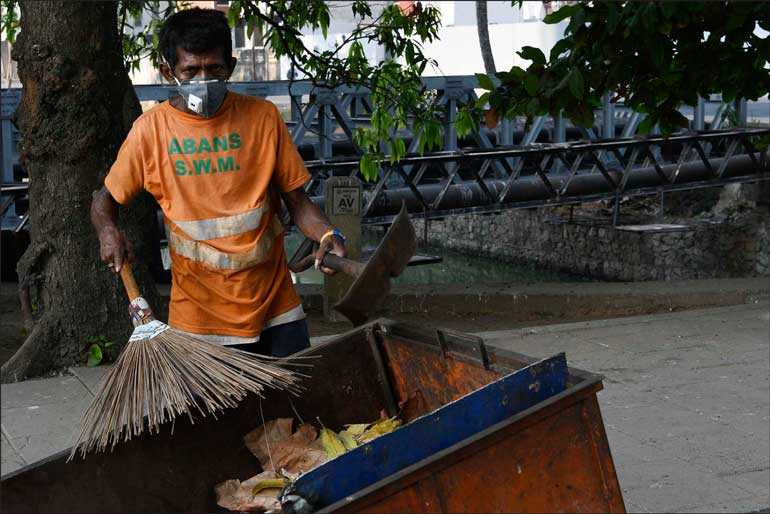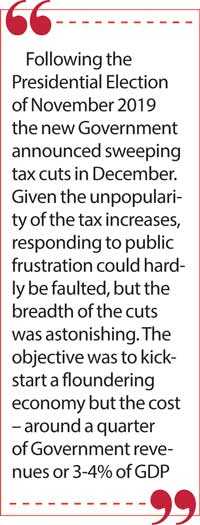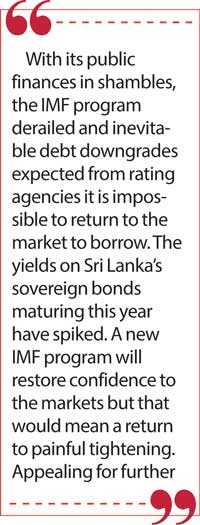Friday Dec 05, 2025
Friday Dec 05, 2025
Thursday, 9 April 2020 00:00 - - {{hitsCtrl.values.hits}}

By Fellows of the Advocata Institute
Sri Lanka’s shaky public finances are about to receive another blow from the fallout of COVID-19. The most crucial aspect of a pandemic is always the human cost, but the spread of the virus has important repercussions for the economy. Studies indicate that pandemic impacts a country’s economy through several channels, including the health, transportation, agricultural and tourism sectors. As borders are closed and global markets slow, trade is impacted, so exports suffer.
Sri Lanka’s already-battered tourism industry will be further hit and the order books of some of the key exporters will suffer in the next quarter. As international supply chains contract exports may remain constrained, even when markets reopen as components and raw materials may remain in short supply. The supply chain impact will affect even domestic producers as imported raw materials run short. Agriculture depends on imported fertiliser, pesticides, planting materials and chemicals. Local factories source raw materials, components and spare parts from overseas and may be unable to work at full capacity.
As cashflow dries up and debts mount, many businesses will find it difficult to cope. During the global financial crisis of 2008/10, an estimated 90,000 Sri Lankans lost their jobs1 due to downsizing amongst manufacturing firms, especially in the apparel sector. The impact of the current crisis has potential to be worse, because unlike the financial crisis, this pandemic is not confined to advanced countries.  Developing countries were affected due to the loss of export markets but their domestic markets were unaffected. This pandemic is affecting both developed and developing countries. Daily wage-earners will see their already uncertain incomes further dampened. Small businesses will be among the hardest hit.
Developing countries were affected due to the loss of export markets but their domestic markets were unaffected. This pandemic is affecting both developed and developing countries. Daily wage-earners will see their already uncertain incomes further dampened. Small businesses will be among the hardest hit.
This would mean that growth will slow further. The budget deficit will take a double hit from falling revenues and increased expenditure. Lower levels of activity mean lower levels of tax collection. As sales and imports decline, the collection of VAT and import taxes will decline. As business profits fall, income tax collection will fall. Meanwhile Government spending on health (from testing kits to hospital costs) and relief measures will rise in response to the pandemic. The budget deficit will thus widen and the Government will need to borrow more. Sri Lanka’s interest bill this year alone will be Rs. 1 trillion.
Even if public finances were robust, this would pose a significant challenge, but Sri Lanka’s finances – sickly to begin with – were weakened by recent tax cuts. The fallout is difficult to estimate but a recap of the principal issues is useful to assess the available policy options.
Sri Lanka obtained an IMF facility of $ 1.5 b in June 2016. This is the 16th instance when it turned to the IMF since joining the fund in 1950 - an indication of the systemic and long-running nature of the underlying problems. The overall objective of the recent IMF program was to “reverse a two-decade decline in tax revenues and put public finances on a sustainable medium-term footing”2. The program aimed to increase Government revenue to reduce the budget deficit and therefore the public debt (as deficits fall, the need to borrow reduces).
In the popular imagination IMF programs are associated with austerity: cutting Government expenditure which negatively impacts social and welfare spending. The reduction in expenditure closes the budget deficit at the expense of the welfare programs. Under the previous ‘Yahapalana’ regime, Sri Lanka did the opposite: increasing taxes to cover the deficit. Expenditure was left untouched and in fact continued to increase.
Unfortunately, the bulk of Government revenue comes through the form of consumption taxes particularly VAT, so much of the burden of increased tax fell on the general public anyway, provoking intense displeasure. Income taxes were also increased, angering the business community. The Government thus succeeded in antagonising a remarkably diverse set of constituents and became exceedingly unpopular.
Public finances did improve somewhat but were never very strong. With the attacks in April 2019 things started to slip again. The IMF review in November 2019 noted that “the fiscal targets are no longer within reach, due to the significant revenue shortfalls”3.
Following the Presidential Election of November 2019 the new Government announced sweeping tax cuts in December. Given the unpopularity of the tax increases, responding to public frustration could hardly be faulted, but the breadth of the cuts was astonishing. Corporate income tax was reduced from 28% to 24%, VAT was halved from 15% to 8% with a high VAT-free threshold; Withholding Tax, Nation Building Tax and Economic Service Charge were scrapped4. The objective was to kick-start a floundering economy but the cost – around a quarter of Government revenues or 3-4% of GDP – destabilised public finances.
On 7 February 2020 the IMF noted that: “Preliminary data indicate that the primary surplus target under the program supported by the Extended Fund Facility (EFF) was missed by a sizeable margin in 2019 with a recorded deficit of 0.3% of GDP, due to weak revenue performance and expenditure overruns”5. According to the fund, Sri Lanka’s 2020 budget deficit could rise to 7.9% of GDP, the highest since 2015. Given the pandemic, this will look optimistic. The reported deficit for 2019 was 6.5% but according to the Ministry of Finance “the actual budget deficit for 2019 should have been over 8%” as around Rs. 367 b of expenditure remained unpaid and unaccounted at the year end6. 
Meanwhile the rating agencies Fitch7 and S&P8 downgraded the outlook on Sri Lanka’s debt to ‘negative’ from ‘stable’. Sri Lanka’s already wobbly public finances must now cope with the added economic shock of COVID-19.
Dealing with the public health emergency and the associated human cost should be top of mind for policymakers. Yet clear-eyed economic thinking will be equally important and will have a direct bearing on the human cost, particularly for our society’s most vulnerable. This is why weighing the relative costs of a lockdown or a complete curfew is important.
The biggest headache for the Government will be managing the foreign debt. The Central Bank’s freshly minted medium term debt strategy is based on assumptions that no longer hold – 5% GDP growth over the medium term, inflation of 5% and a budget deficit of 3.5%. With the medium term strategy in ruins can the Government rollover the maturing debt?
Gross reserves stood at $ 7.9 b9 equivalent to 4.6 months of imports at February 2020. External debt repayments are around $ 5.6 b in 2020. This has been partially refinanced by a $ 500 m loan10 from China which has reportedly promised a further $ 700 m. The country will be looking to raise a further $ 2-2.5 b at least if it intends to repay this year’s debt while maintaining a minimum reserve of three months imports.
With its public finances in shambles, the IMF program derailed and inevitable debt downgrades expected from rating agencies it is impossible to return to the market to borrow. The yields on Sri Lanka’s sovereign bonds maturing this year have spiked. At the time of writing investors were asking for a 101% increment on the current yield, bonds maturing next year are at 44%. A new IMF program will restore confidence to the markets but that would mean a return to painful tightening. Appealing for further bailouts is thus the most attractive option.
Sri Lanka is among the countries that have called for debt relief. The call has been supported by the World Bank and the International Monetary Fund (IMF).11 Although the call is for the poorest of countries, there are signs that these organisations will consider countries recently transitioned into upper middle income category like Sri Lanka.
Some commentators have even suggested that the Government should simply default12. While this may appear simple, it is risky and even restructuring of commercial debt:deferring or reducing repayments is viewed by the markets as a default event, which means it will be difficult to return to the markets for a while. It also delivers a shock to the economy with declines in GDP, investment, and private sector credit being common. The financial sector may be affected leading to bank failures.
An IMF study in 2002 covering restructurings by Russia, Ukraine, Ecuador and Pakistan in 1998-2000 showed as a result of the restructuring:
“The decline of real income and financing was transmitted to domestic demand. Confidence plummeted and private investment was curtailed sharply. Private consumption followed, albeit with a lag, as for a while households drew down their available savings. Public consumption was also scaled down reflecting efforts to consolidate public finances. Despite exchange controls, exchange rates depreciated sharply reflecting the shortage of foreign funds resulting from capital flight. The domestic demand contraction and import substitution helped improve current accounts. The exchange rate depreciation passed quickly to prices and inflation surged. Wages lagged, inflation wiped out the value of deposits, unemployment rose, and households suffered significant real income losses.”13
Sri Lanka thus finds itself in a tricky position with little room to manoeuvre. These problems are not due to COVID-19 alone, although it has made matters much worse. The pandemic has only precipitated the policy weaknesses that were building up over decades into a single giant shock encompassing growth, fiscal and external sectors at the same time.
This was also the case in the countries in the IMF study referred above where following a relatively short history of access to international capital markets, the macroeconomic situation was destabilised by domestic policy shortcomings and exogenous shocks: weak oil prices for Russia and Ecuador, international sanctions following nuclear testing for Pakistan, the El-Niño effect for Ecuador, Russia’s turmoil for Ukraine, in addition to an unfavourable external environment after the Asian crisis.
In the short-term bailouts will be necessary, but it is only a temporary measure, postponing the issues for a later but not too distant date. Whilst further bi-lateral loans from China are a possibility, given the global nature of the Covid-19 crisis, further bi-lateral aid may not be a realistic option. With its $ 1 trillion lending capacity, an IMF program provides perhaps the only realistic option to access further borrowing.
Politicians and citizens who have been living in a state of denial must wake up to the grim realities. Pre-election bravado and long touted conspiracy theories must give away to level-headed thinking and negotiations with global financial institutions. Economic management should be done in consultation with all other statutory agencies that are empowered to play a role.
Mistakes could be costly and run the risk of turning the COVID-19 outbreak from a severe public health crisis into a devastating economic crisis.
(The authors are fellows of the Advocata Institute, a free-market think tank based in Colombo, Sri Lanka. For more insights and commentary on COVID-19 from Advocata, visit www.advocata.org/covid19)
Footnotes
1 Daily News 9 Jul 2009. Over 180 countries adopt Global Jobs Pact. [ONLINE] Available at: http://archives.dailynews.lk/2009/07/09/bus10.asp. [Accessed 29 March 2020].
2 IMF.3 June 2016. IMF Executive Board Approves Three-Year US$1.5 Billion Extended Arrangement under EFF for Sri Lanka. [ONLINE] Available at: https://www.imf.org/en/News/Articles/2015/09/14/01/49/pr16262. [Accessed 29 March 2020].
3 IMF. 4 Nov 2019. Sixth Review Under the Extended Arrangement Under the Extended Fund Facility and Requests for Waiver of Nonobservance and Modification of Performance Criterion-Press Release; Staff Report; and Statement by the Executive Director for Sri Lanka. [ONLINE] Available at: https://www.imf.org/en/Publications/CR/Issues/2019/11/04/Sri-Lanka-Sixth-Review-Under-the-Extended-Arrangement-Under-the-Extended-Fund-Facility-and-48787. [Accessed 29 March 2020].
4 Ministry of Finance, Economic and Policy Development. 23 Mar 2020. Pre Election Budgetary Position Report. [ONLINE] Available at: http://treasury.gov.lk/documents/10181/829992/Pre-Election+Budgetary+Position+Report-2020-20200323-2/d489aa0a-edb8-47e4-bab0-af51b68d2132. [Accessed 29 March 2020].
5 IMF. 7 Feb 2020. IMF Staff Concludes Visit to Sri Lanka. [ONLINE] Available at: https://www.imf.org/en/News/Articles/2020/02/07/pr2042-sri-lanka-imf-staff-concludes-visit-to-sri-lanka. [Accessed 29 March 2020].
6 Ministry of Finance, Economic and Policy Development. 23 Mar 2020. Pre Election Budgetary Position Report. [ONLINE] Available at: http://treasury.gov.lk/documents/10181/829992/Pre-Election+Budgetary+Position+Report-2020-20200323-2/d489aa0a-edb8-47e4-bab0-af51b68d2132. [Accessed 29 March 2020].
7 Economynext, 19 Dec 2019. Sri Lanka sovereign rating outlook downgraded to ‘negative’ by Fitch over tax cuts. [ONLINE] Available at: https://economynext.com/sri-lanka-sovereign-rating-outlook-downgraded-to-negative-by-fitch-over-tax-cuts-36605/. [Accessed 29 March 2020].
8 Economynext. 14 Jan 2020. Sri Lanka credit outlook downgraded to negative on tax cuts by Standard and Poor’s. [ONLINE] Available at: https://economynext.com/sri-lanka-credit-outlook-downgraded-to-negative-on-tax-cuts-by-standard-and-poors-40118/. [Accessed 29 March 2020].
9 Adaderana Biz. 12 Mar 2020. Sri Lanka official reserves increase to US$ 7.9bn in February 2020. [ONLINE] Available at: http://bizenglish.adaderana.lk/sri-lanka-official-reserves-increase-to-us-7-9bn-in-february-2020/. [Accessed 29 March 2020]
10 ColomboPage. 18 Mar 2020. China grants US$ 500 million concessionary loan to Sri Lanka to fight coronavirus pandemic. [ONLINE] Available at: http://www.colombopage.com/archive_20A/Mar18_1584548120CH.php. [Accessed 29 March 2020
11 Euromoney. 26 Mar 2020. Debt relief for Africa as coronavirus Covid-19 crisis intensifies [ONLINE] Available at: https://www.euromoney.com/article/b1kxnyc2th4x6d/debt-relief-for-africa-as-coronavirus-covid-19-crisis-intensifies. [Accessed 29 March 2020].
12 Ceylon Today. 10 Jan 2020. Sovereign debt: Why not default?. [ONLINE] Available at: https://ceylontoday.lk/print-more/49288. [Accessed 29 March 2020]
13 IMF. 21 Feb 2002. Sovereign Debt Restructurings and the Domestic Economy Experience in Four Recent Cases. [ONLINE] Available at: https://www.imf.org/external/NP/pdr/sdrm/2002/022102.pdf. [Accessed 29 March 2020].